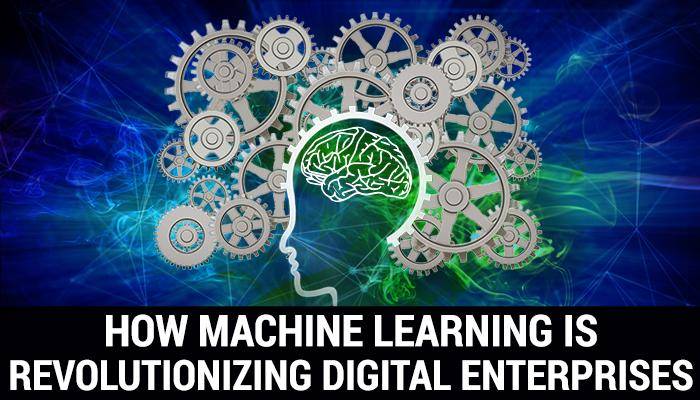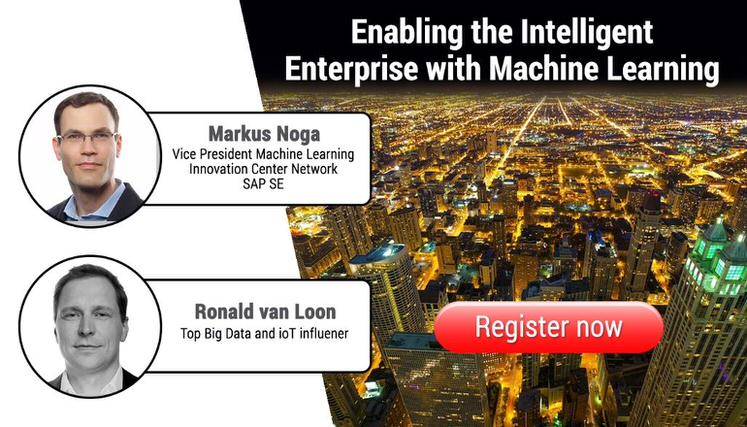According to the prediction of IDC Futurescapes, two-thirds of Global 2000 Enterprises CEOs will center their corporate strategy on digital transformation. A major part of the strategy should include machine-learning (ML) solutions. The implementation of these solutions could change how these enterprises view customer value and internal operating model today.
If you want to stay ahead of the game, then you cannot afford to wait for that to happen. Your digital business needs to move towards automation now while ML technology is developing rapidly. Machine learning algorithms learn from huge amounts of structured and unstructured data, e.g. text, images, video, voice, body language, and facial expressions. By that, it opens a new dimension for machines with limitless applications from healthcare systems to video games and self-driving cars.
In short, ML will connect intelligently people, business, and things. It will enable completely new interaction scenarios between customers and companies and eventually allow a true intelligent enterprise. To realize the applications that are possible due to ML fully, we need to build a modern business environment. However, this will only be achieved, if businesses can understand the distinction between Artificial Intelligence (AI) and Machine Learning (ML).
Understanding the Distinction Between ML and AI
Machines that could fully replicate or even surpass all humans’ cognitive functions are still a dream of Science Fiction stories, Machine Learning is the reality behind AI and it is available today. ML mimics how the human cognitive system functions and solves problems based on that functioning. It can analyze data that is beyond human capabilities.
The ML data analysis is based on the patterns it can identity in Big Data. It can make UX immersive and efficient while also being able to respond with human-like emotions. By learning from data instead of being programmed explicitly, computers can now deal with challenges previously reserved to the human. They now beat us at games like chess, go and poker; they can recognize images more accurately, transcribe spoken words more precisely, and are capable of translating over a hundred languages.
ML applications for life and business
In order for us to comprehend the range of applications that will be possible due to ML technology, let us look at some examples available currently:
- Home connections: Amazon Echo, Google Home
- Digital assistants: Apple’s Siri, SAP’s upcoming Copilot
Both types of devices provide an interactive experience for the users due to Natural Language Processing technology. With ML in the picture, this experience might be taken to new heights, i.e., chatbots. Initially, they will be a part of the apps mentioned above but it is predicted that they could make text and GUI interfaces obsolete.
ML technology does not force the user to learn how it can be operated but adapts itself to the user. It will become much more than give birth to a new interface; it will lead to the formation of enterprise AI.
The limitless ways in which ML can be applied include provision of completely customized healthcare. It will be able to anticipate the customer’s needs due to their shopping history. It can make it possible for the HR to recruit the right candidate for each job without bias and automate payments in the finance sector.
Unprecedented business benefits via ML
Business processes will become automated and evolve with the increasing use of ML due to the benefits associated with it. Customers can use the technology to pick the best results and thus, reach decisions faster. As the business environment changes, so will the advanced machines as they constantly update and adapt themselves. ML will also help businesses arrive on innovations and keep growing by providing the right kind of business products/services and basing their decisions on a business model with the best outcome.
ML technology is able to develop insights that are beyond human capabilities based on the patterns it derives from Big Data. As a result, businesses would be able to act at the right time and take advantage of sales opportunities, converting them into closed deals. With the whole operation optimized and automated, the rate at which a business grows will accelerate. Moreover, the business process will achieve more at a lesser cost. ML will lead businesses into environs with minimal human error and stronger cybersecurity.
ML use cases
The following three examples show how ML can be applied to an enterprise model that utilizes Natural Language Processing:
Support Ticket Classification
Consider the case where tickets from different media channels (email, social websites etc.) need to be forwarded to the right specialist for the topic. The immense volume of support tickets makes the task lengthy and time-consuming. If ML were to be applied to this situation, it could be useful in classifying them into different categories.
API and micro-service integration could mean that the ticket could be automatically categorized. If the number of correctly categorized tickets is high enough, an ML algorithm can route the ticket directly to the next service agent without the need of a support agent.
Recruiting
The job of prioritizing incoming applications for positions with hundreds of applicants can also be slow and time-consuming. If automated via ML, the HR can let the machine predict candidate suitability by providing it with a job description and the candidate’s CV. A definite pattern would be visible in the CVs of suitable candidates, such as the right length, experience, absence of typos, etc. Automation of the process will be more likely to provide the right candidate for the job.
Marketing
ML will help build logo and brand recognition for businesses in the following two ways:
- With the use of a brand intelligence app, the identification of logos in event sponsorship videos or TV can lead to marketing ROI calculations.
- Stay up to date on the customer’s transactions and use that behavior to predict how to maintain customer loyalty and find the best way to retain them.
How enterprises can get started
Businesses can step into the new age of ML and begin implementing the technique by letting the machines use Big Data derived from various sources, e.g. images, documents, IoT devices etc to learn. While these machines can automate lengthy and repetitive tasks, they can also be used to predict the outcome for new data. The first step in the implementation of ML for a business should be to educate themselves about its nature and the range of its applications. A free openSAP course can help make that possible.
Another step that can bring a business closer to ML implementation is data preparation in complex landscapes. The era of information silos is over and there is an imperative need for businesses to gather data from various sources, such as customers, partners, and suppliers. The algorithms must then be provided open access to that data so they can learn and evolve. The Chief Data Officer of the company can oversee the ML integration process.
To start with completely new use cases for Machine Learning is not easy and requires a good understanding of the subject and having the right level of expertise in the company. A better starting point for many companies would be to rely on ML solutions already integrated into standard software. By that, it will connect seamlessly with the existing business process and immediately start to create value.
Lastly, businesses should start gathering the components necessary for building AI products. Among the requirements would be a cloud platform capable of handling high data volume that is derived from multiple sources. The relevant people are as important to this step as are the technology and processes. After all, they would be the ones who will be testing the latest digital and ML technologies.
If you want more information on SAP Machine Learning, then go here to subscribe to the webinar on Enabling the intelligent Enterprise with Machine Learning.
The presenters include Dr. Markus Noga: VP Machine Learning SAP Innovation Center Network, SAP SE. You can follow him on Twitter.
Ronald van Loon is the other presenter for the webinar. Mr. Loon is counted among the Top 10 Big Data expert and is an IoT Influencer.












